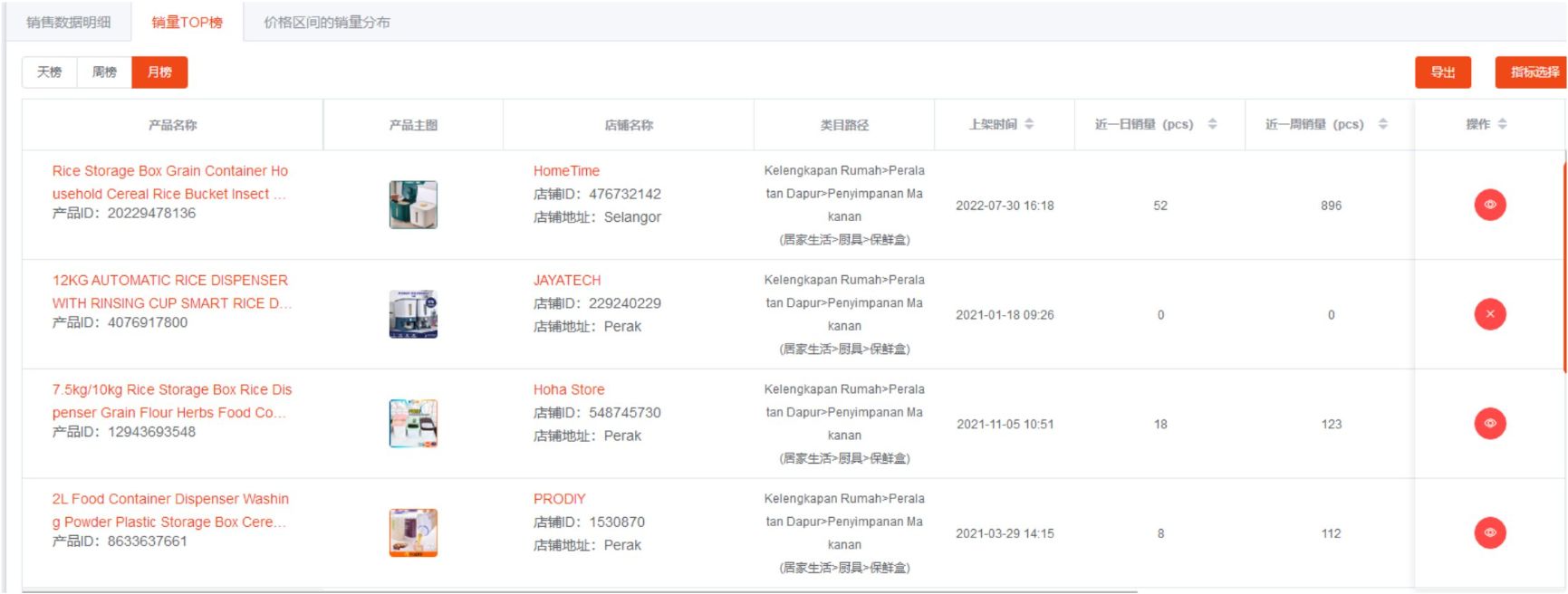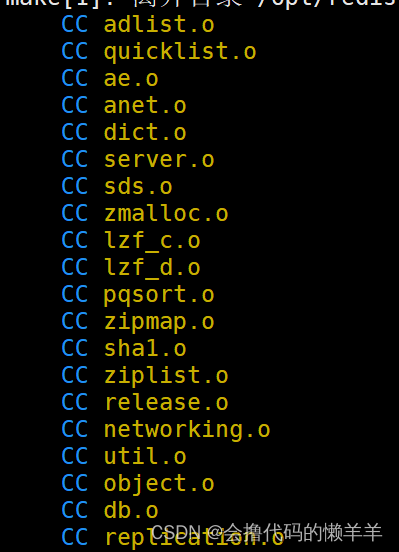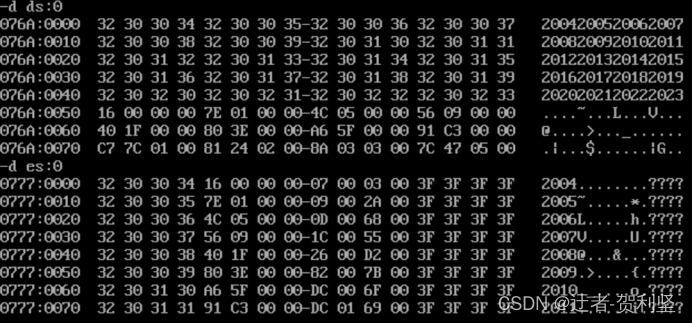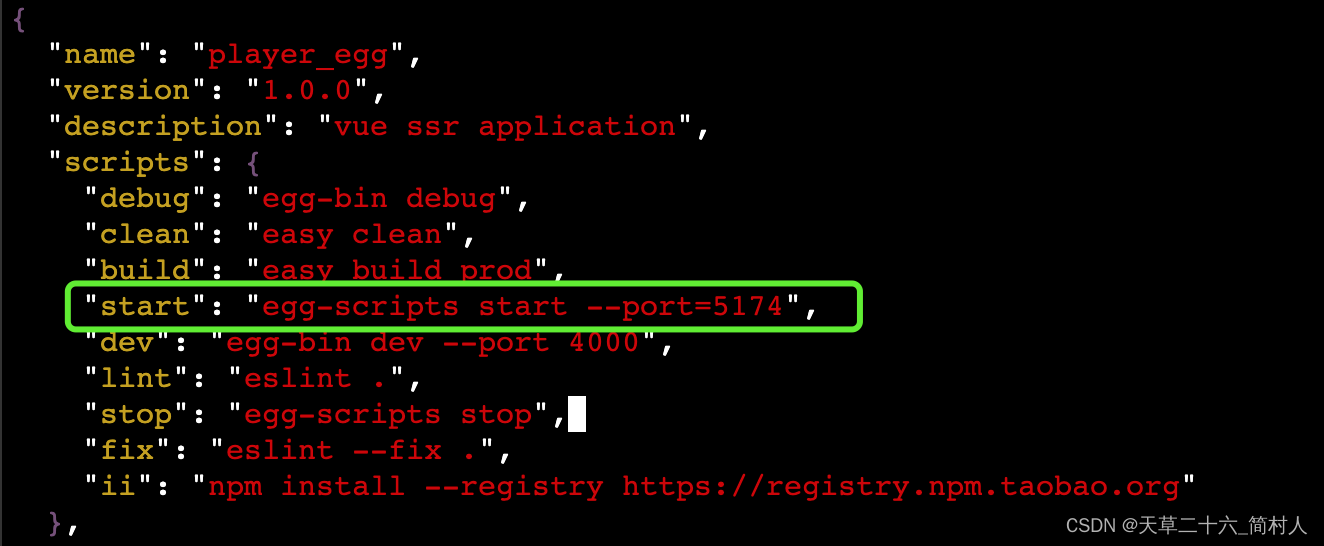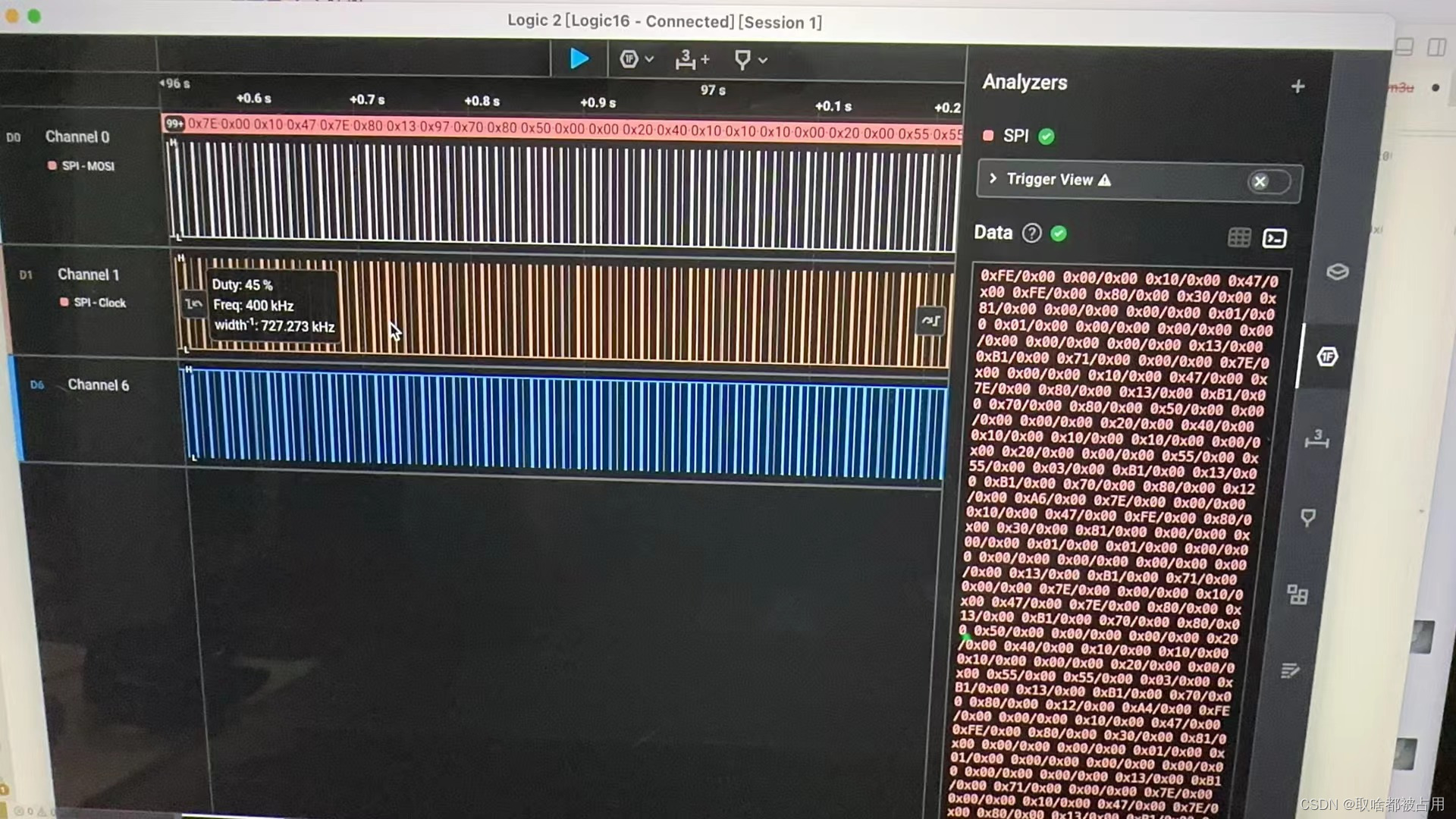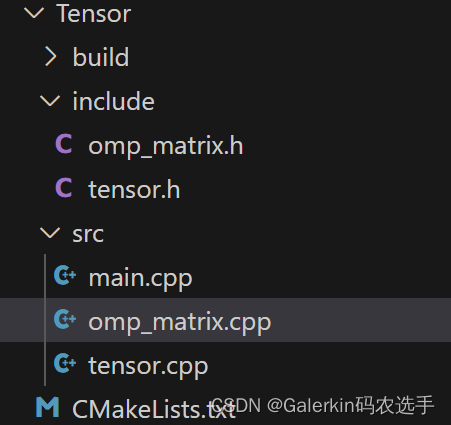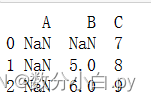目录
Dict的组成
1.hash表的节点
2.hash表结构
3.字典
4.Dict结构
hash算法
哈希函数
什么情况下使用
rehash
rehash主要的函数dictExpand
怎么判断要进行扩容还是收缩
什么时候会用到扩展和收缩
渐进式rehash
渐进式rehash主要的函数dictRehash
字典API
字典的创建dictCreate
增加键值对dictAdd
查找给定键的值dictFetchValue
删除给定的键dictDelete
添加或覆盖键值对(更新键值对)dictReplace
Redis是一个键值型(Key - Value Pair)的数据库,我们可以根据键实现快速的增删改查。而键与值的映射关系正是通过Dict来实现的。
Dict的组成
Dict由三部分组成,分别是:哈希表(DictHashTable)、哈希节点(DictEntry)、字典(Dict)
1.hash表的节点
//dict.h
typedef struct dictEntry {
void *key;
union {
void *val;
uint64_t u64;
int64_t s64;
double d;
} v;
struct dictEntry *next;
} dictEntry;- hash表的节点, 主要是包含了key, val键值对和下一个节点的指针,。从该结构体我们可以看出, 这些节点会组成一个单向链表。
- hash表的key是
Void *指针类型,可以存储多种类型的数据, 值 v 是一个共用体, 也可以是uint64整数, 也可以是int64整数, 还可以是浮点数。
2.hash表结构
typedef struct dictht {
dictEntry **table; //hash表数组,元素是 dictEntry*指针类型的
unsigned long size; //数组大小
unsigned long sizemask; //hash数组长度掩码, sizemask = size - 1
unsigned long used; //hash表的已有的entry的个数
} dictht;- 由hash表结构, 可知redis是通过数组做hash散列的.
- hash表数组的
size长度一般为 2^n 的大小, 保证这样的大小可以通&操作来计算出hash槽的位置。因为如果数组容量不是2^n的大小, 那么就需要通过取模来获取hash表的槽索引, 取模操作相对&操作性能会差一些. szimmask表示数组掩码, 一般是size-1, 如: 假如数组长度为8, 那么掩码就为7, 掩码转换成二进制就为 ob00000111
3.字典
type和privdata字段是针对不同类型的键值对,为创建多态字典而设计的。- type 字段是一个指向
dictType结构的指针,每个dictType结构保存了一簇用于操作特定类型键值对的函数,Redis 会为用途不同的字典设置不同的类型特定函数。 - privdata 字段则保存了需要传给那些类型特定函数的可选参数。
- ht 字段是一个包含两个项的数组,数组中的每个项都是一个
dictht哈希表。一般情况下,只使用ht[0],只有当哈希表的键值对数量超过负载(元素过多)时,才会将键值对迁移到ht[1],这一步迁移被称为 rehash (重哈希)。 - rehashidx 字段也是和 rehash 有关,用于记录目前 rehash 的进度,如果没有 rehash,值就是 -1。
- pauserehash代表rehash是否暂停。
typedef struct dict {
dictType *type; //内置一些不同类型的hash函数
void *privdata; //携带的私有数据
dictht ht[2]; //hash字典的数组, 长度为2, 主要是用于渐进式hash时使用
long rehashidx; //rehash的进度, -1表示未进行
int16_t pauserehash; //rehash是否暂停, 1则暂停,0则继续
} dict;
//字典类型 该结构体内部是一些函数指针
typedef struct dictType {
uint64_t (*hashFunction)(const void *key); //计算hash值的函数
void *(*keyDup)(void *privdata, const void *key);
void *(*valDup)(void *privdata, const void *obj);
int (*keyCompare)(void *privdata, const void *key1, const void *key2);
void (*keyDestructor)(void *privdata, void *key);
void (*valDestructor)(void *privdata, void *obj);
int (*expandAllowed)(size_t moreMem, double usedRatio);
} dictType;4.Dict结构
了解了上面的三个结构体,就可以知道Dict的结构了。
Dict使用了哈希表,其实就是一个数组,数组的每个元素称为一个哈希桶。所以,我们常说,一个哈希表是由多个哈希桶组成的,每个哈希桶中保存了键值对数据。
hash表一般的实现都是数组+链表来实现。 数组来做hash散列, 链表用来解决hash冲突的问题
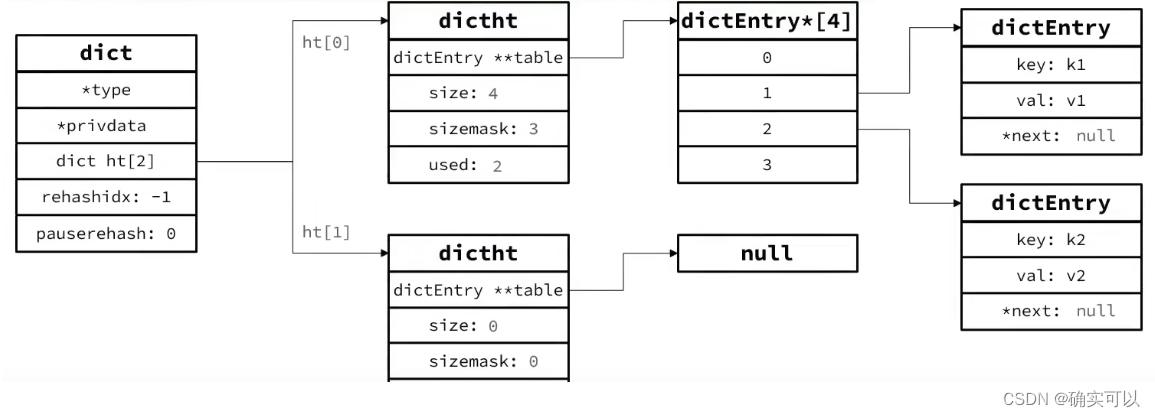
hash算法
哈希函数
类型处理函数中的第一个函数 hashFunction 就是计算某个键的哈希值的函数,对于不同类型的 key,哈希值的计算是不同的,所以在字典进行创建的时候,需要指定哈希函数。
redis默认使用的是dictGenHashFunction函数。dictGenHashFunction内部就只是调用了siphash函数。siphash是复杂的,但我们只需要知道有这么些函数就行了。
uint64_t dictGenHashFunction(const void *key, int len) {
return siphash(key,len,dict_hash_function_seed);
}
uint64_t siphash(const uint8_t *in, const size_t inlen, const uint8_t *k) {
#ifndef UNALIGNED_LE_CPU
uint64_t hash;
uint8_t *out = (uint8_t*) &hash;
#endif
uint64_t v0 = 0x736f6d6570736575ULL;
uint64_t v1 = 0x646f72616e646f6dULL;
uint64_t v2 = 0x6c7967656e657261ULL;
uint64_t v3 = 0x7465646279746573ULL;
uint64_t k0 = U8TO64_LE(k);
uint64_t k1 = U8TO64_LE(k + 8);
uint64_t m;
const uint8_t *end = in + inlen - (inlen % sizeof(uint64_t));
const int left = inlen & 7;
uint64_t b = ((uint64_t)inlen) << 56;
v3 ^= k1;
v2 ^= k0;
v1 ^= k1;
v0 ^= k0;
for (; in != end; in += 8) {
m = U8TO64_LE(in);
v3 ^= m;
SIPROUND;
v0 ^= m;
}
switch (left) {
case 7: b |= ((uint64_t)in[6]) << 48; /* fall-thru */
case 6: b |= ((uint64_t)in[5]) << 40; /* fall-thru */
case 5: b |= ((uint64_t)in[4]) << 32; /* fall-thru */
case 4: b |= ((uint64_t)in[3]) << 24; /* fall-thru */
case 3: b |= ((uint64_t)in[2]) << 16; /* fall-thru */
case 2: b |= ((uint64_t)in[1]) << 8; /* fall-thru */
case 1: b |= ((uint64_t)in[0]); break;
case 0: break;
}
v3 ^= b;
SIPROUND;
v0 ^= b;
v2 ^= 0xff;
SIPROUND;
SIPROUND;
b = v0 ^ v1 ^ v2 ^ v3;
#ifndef UNALIGNED_LE_CPU
U64TO8_LE(out, b);
return hash;
#else
return b;
#endif
}什么情况下使用
- 在当要将一个新的键值对添加到字典里面 或者 通过键查找值的时候
- 出现哈希冲突的时候使用
那么在插入或者查找dictEntry 时候,我们就需要找到其所在下标的索引。(哈希表是个数组)具体算法如下:
1.通过宏 dictHashKey 计算得到该键对应的哈希值
#define dictHashKey(d, key) (d)->type->hashFunction(key)2.将哈希值和哈希表的 sizemask 属性做位与(相当于取模运算),得到索引值 index,其中 ht[x] 可以是 ht[0] 或者 ht[1]。
index = dictHashKey(d, key) & d->ht[x].sizemask;3.哈希冲突
redis字典实现是使用链地址法。
哈希冲突那肯定是在键值对插入的时候。看看键值对插入函数dictAdd。
int dictAdd(dict *d, void *key, void *val)
{
dictEntry *entry = dictAddRaw(d,key,NULL);
if (!entry) return DICT_ERR;
dictSetVal(d, entry, val);
return DICT_OK;
}
#define dictSetVal(d, entry, _val_) do { \
if ((d)->type->valDup) \
(entry)->v.val = (d)->type->valDup((d)->privdata, _val_); \
else \
(entry)->v.val = (_val_); \
} while(0)dictAdd会调用dictAddRaw生成一个新的哈希节点,然后调用dictSetVal去设置这个哈希节点的val值,那么剩下key还没有设置,设置key在dictAddRaw函数内。
dictEntry *dictAddRaw(dict *d, void *key, dictEntry **existing)
{
long index;
dictEntry *entry;
dictht *ht;
if (dictIsRehashing(d)) _dictRehashStep(d);//若符合,则执行rehash
if ((index = _dictKeyIndex(d, key, dictHashKey(d,key), existing)) == -1)//1.获取索引
return NULL;
//2.根据是否rehash状态获取ht[1]还是获取ht[0],如果正在refash,则用哈希表ht[1]进行插入
ht = dictIsRehashing(d) ? &d->ht[1] : &d->ht[0];
//3.分配内存生成新的hash节点,然后在链表头部插入这个hash节点,
entry = zmalloc(sizeof(*entry));
entry->next = ht->table[index];
ht->table[index] = entry;
ht->used++;
//4.设置键
dictSetKey(d, entry, key);
return entry;
}rehash
随着字典操作的不断执行,哈希表保存的键值对会不断增多或减少。当哈希表保存的键值对数量太多或者太少时,需要对哈希表大小进行扩容或者收缩。
而不管是扩容还是收缩,必定是会创建新的哈希表这会导致哈希表的size和sizemask发生变化,而key的查询是于sizemask相关的。所以必须对哈希表中的每一个key进行重新计算索引,然后插入新的哈希表,这个过程就是rehash。
过程如下:
- 计算出新hash表的realsize
- 按照新的realsize申请内存空间,创建dictht,并赋值给dicth.ht[1]
- 设置dict.rehashidx=0,表示开始rehash
rehash主要的函数dictExpand
int dictExpand(dict *d, unsigned long size) {
return _dictExpand(d, size, NULL);
}
int _dictExpand(dict *d, unsigned long size, int* malloc_failed)
{
if (malloc_failed) *malloc_failed = 0;
/* the size is invalid if it is smaller than the number of
* elements already inside the hash table */
if (dictIsRehashing(d) || d->ht[0].used > size)
return DICT_ERR;
//步骤1,计算出新的realsize
dictht n; /* the new hash table */
unsigned long realsize = _dictNextPower(size);
/* Detect overflows */
if (realsize < size || realsize * sizeof(dictEntry*) < realsize)
return DICT_ERR;
/* Rehashing to the same table size is not useful. */
if (realsize == d->ht[0].size) return DICT_ERR;
//步骤2,申请内存空间,创建dictht
/* Allocate the new hash table and initialize all pointers to NULL */
n.size = realsize;
n.sizemask = realsize-1;
if (malloc_failed) {
n.table = ztrycalloc(realsize*sizeof(dictEntry*));
*malloc_failed = n.table == NULL;
if (*malloc_failed)
return DICT_ERR;
} else
n.table = zcalloc(realsize*sizeof(dictEntry*));
n.used = 0;
/* Is this the first initialization? If so it's not really a rehashing
* we just set the first hash table so that it can accept keys. */
if (d->ht[0].table == NULL) {
d->ht[0] = n;
return DICT_OK;
}
//步骤3,设置rehashidx=0,标识开始rehash
/* Prepare a second hash table for incremental rehashing */
d->ht[1] = n;
d->rehashidx = 0;
return DICT_OK;
}
//哈希表大小是二次幂
/* Our hash table capability is a power of two */
static unsigned long _dictNextPower(unsigned long size)
{
unsigned long i = DICT_HT_INITIAL_SIZE;
if (size >= LONG_MAX) return LONG_MAX + 1LU;
while(1) {
if (i >= size)
return i;
i *= 2;
}
}怎么判断要进行扩容还是收缩
- 触发扩容的条件,负载因子>5
负载因子 = 保存的节点数(used)/ 哈希表大小(size)。
即是load_factor = ht[0].used / ht[0].size。
static int dict_can_resize = 1;
static unsigned int dict_force_resize_ratio = 5;
static int _dictExpandIfNeeded(dict *d)
{
/* Incremental rehashing already in progress. Return. */
if (dictIsRehashing(d)) return DICT_OK;
// 大小为0需要设置初始哈希表大小为4
if (d->ht[0].size == 0) return dictExpand(d, DICT_HT_INITIAL_SIZE);
/* If we reached the 1:1 ratio, and we are allowed to resize the hash
* table (global setting) or we should avoid it but the ratio between
* elements/buckets is over the "safe" threshold, we resize doubling
* the number of buckets. */
if (d->ht[0].used >= d->ht[0].size &&
(dict_can_resize ||
d->ht[0].used/d->ht[0].size > dict_force_resize_ratio) &&
dictTypeExpandAllowed(d)) // 负载因子超过5,执行 dictExpand
{
return dictExpand(d, d->ht[0].used + 1);
}
return DICT_OK;
}- 触发收缩的条件:哈希表的负载因子小于 0.1 时
//dict.c
int dictResize(dict *d)
{
unsigned long minimal;
if (!dict_can_resize || dictIsRehashing(d)) return DICT_ERR;
minimal = d->ht[0].used;
if (minimal < DICT_HT_INITIAL_SIZE)
minimal = DICT_HT_INITIAL_SIZE;
return dictExpand(d, minimal);
}
//dictResize函数的使用场景
//server.h
#define HASHTABLE_MIN_FILL 10 /* Minimal hash table fill 10% */
//server.c
int htNeedsResize(dict *dict) {
long long size, used;
size = dictSlots(dict);
used = dictSize(dict);
return (size > DICT_HT_INITIAL_SIZE &&
(used*100/size < HASHTABLE_MIN_FILL));
}
void tryResizeHashTables(int dbid) {
if (htNeedsResize(server.db[dbid].dict))
dictResize(server.db[dbid].dict);
....................
}扩展或收缩哈希表都是用到了函数dictExpand,而新的哈希表最终大小都是 2 的 n 次幂
什么时候会用到扩展和收缩
- 扩展是在每次执行添加键值对或者修改键值对时候进行判断的,即是每次添加键值对的时候都会执行_dictExpandIfNeeded。
- 判断是否需要收缩是可以认为是使用定时器,定时去对比判断的。
dictExpand只是扩展了哈希表,还没有把哈希表内的键值对保存到ht[1]中,这个操作在其他地方进行的。这就需要到渐进式rehash。
渐进式rehash
扩展和收缩哈希表都需要将 ht[0] 里面的所有键值对 rehash 到 ht[1] 里面。但是,rehash 动作并不是一次性、集中式完成的,而是分多次、渐进式地完成的。因为一次性将所有键值对全部 rehash 到 ht[1] 的话,庞大的计算量可能会导致服务器在一段时间内停止服务。
渐进式rehash主要的函数dictRehash
- 每次进行新增、查询、修改、删除时,都会检查下dict.rehashidx是否大于-1,如果是则将dict.ht[0].table[rehashidx]的entry链表赋值给dict.ht[1]中,并将rehashidx++。直至dict.ht[0]的所有数据都rehash到dict.ht[1]中。
- 将dict.ht[1]赋值给dict.ht[0],将dict.ht[1]初始化为空哈希表,并释放原来的dict.ht[0]内存。
- 将rehashidx赋值为-1,代表rehash结束。
注意:在rehash过程中,新增操作的话,是直接写入到ht[1],而查询、修改和删除则是会在dict.ht[0]和dict.ht[1]依次查找并执行。这样可以确保ht[0]的数据只减不增,随着rehash最终变为空。
渐进式rehash做的优化:为了防止 ht[0] 是个稀疏表 (遍历很久遇到的都是NULL),从而导致函数阻塞时间太长,rehash做了个优化,引入“最大空格访问数”,也即代码中的 enmty_visits,初始值为 n*10。当遇到NULL的数量超过这个初始值直接返回。
//dictRehash被_dictRehashStep调用
static void _dictRehashStep(dict *d) {
if (d->pauserehash == 0) dictRehash(d,1);
}
//每次执行增加、删除等操作时候,都会判断是否要执行_dictRehashStep
int dictRehash(dict *d, int n) {
//最多有10*n个空桶
int empty_visits = n*10; /* Max number of empty buckets to visit. */
if (!dictIsRehashing(d)) return 0;
while(n-- && d->ht[0].used != 0) {
dictEntry *de, *nextde;
/* Note that rehashidx can't overflow as we are sure there are more
* elements because ht[0].used != 0 */
assert(d->ht[0].size > (unsigned long)d->rehashidx);
//是空桶的话,且超过10*n个空桶,就跳过
while(d->ht[0].table[d->rehashidx] == NULL) {
d->rehashidx++;
if (--empty_visits == 0) return 1;
}
de = d->ht[0].table[d->rehashidx];
/* Move all the keys in this bucket from the old to the new hash HT */
while(de) {
uint64_t h;
nextde = de->next;
/* Get the index in the new hash table */
h = dictHashKey(d, de->key) & d->ht[1].sizemask;
de->next = d->ht[1].table[h];
d->ht[1].table[h] = de;
d->ht[0].used--;
d->ht[1].used++;
de = nextde;
}
d->ht[0].table[d->rehashidx] = NULL;
d->rehashidx++;
}
//判断是否已经把ht[0]的所有数据都rehash到ht[1],若是则赋值ht[0]
if (d->ht[0].used == 0) {
zfree(d->ht[0].table);
d->ht[0] = d->ht[1];
_dictReset(&d->ht[1]);
d->rehashidx = -1;
return 0;
}
/* More to rehash... */
return 1;
}渐进式 rehash 的好处在于它采取分而治之的方式,将 rehash 键值对所需的计算工作均摊到对字典的每个添加、删除、查找和更新操作上,从而避免了集中式 rehash 而带来的庞大计算量。
字典API
字典的创建dictCreate
主要是分配空间,初始化一些数据。
static void _dictReset(dict *ht) {
ht->table = NULL;
ht->size = 0;
ht->sizemask = 0;
ht->used = 0;
}
/* Create a new hash table */
static dict *dictCreate(dictType *type, void *privDataPtr) {
dict *ht = malloc(sizeof(*ht));
_dictInit(ht,type,privDataPtr);
return ht;
}
/* Initialize the hash table */
static int _dictInit(dict *ht, dictType *type, void *privDataPtr) {
_dictReset(ht);
ht->type = type;
ht->privdata = privDataPtr;
return DICT_OK;
}增加键值对dictAdd
- 判断是否需要进行rehash的。
- 通过哈希函数找到要插入的key的槽位置(通过函数_dictKeyIndex)
- 判断要插入哪个哈希表,并插入,最终设置value。
/* Add an element to the target hash table */
int dictAdd(dict *d, void *key, void *val)
{
dictEntry *entry = dictAddRaw(d,key,NULL);
if (!entry) return DICT_ERR;
dictSetVal(d, entry, val);
return DICT_OK;
}
dictEntry *dictAddRaw(dict *d, void *key, dictEntry **existing)
{
long index;
dictEntry *entry;
dictht *ht;
if (dictIsRehashing(d)) _dictRehashStep(d);//判断是否需要进行rehash
/* Get the index of the new element, or -1 if
* the element already exists. */
if ((index = _dictKeyIndex(d, key, dictHashKey(d,key), existing)) == -1)
return NULL;
/* Allocate the memory and store the new entry.
* Insert the element in top, with the assumption that in a database
* system it is more likely that recently added entries are accessed
* more frequently. */
ht = dictIsRehashing(d) ? &d->ht[1] : &d->ht[0];
entry = zmalloc(sizeof(*entry));
entry->next = ht->table[index];
ht->table[index] = entry;
ht->used++;
/* Set the hash entry fields. */
dictSetKey(d, entry, key);
return entry;
}
static long _dictKeyIndex(dict *d, const void *key, uint64_t hash, dictEntry **existing)
{
unsigned long idx, table;
dictEntry *he;
if (existing) *existing = NULL;
/* Expand the hash table if needed */
if (_dictExpandIfNeeded(d) == DICT_ERR)
return -1;
for (table = 0; table <= 1; table++) {
idx = hash & d->ht[table].sizemask;
/* Search if this slot does not already contain the given key */
he = d->ht[table].table[idx];
while(he) {
if (key==he->key || dictCompareKeys(d, key, he->key)) {
if (existing) *existing = he;
return -1;
}
he = he->next;
}
if (!dictIsRehashing(d)) break;
}
return idx;
}查找给定键的值dictFetchValue
利用 dictFind 找到给定键的 dictEntry,然后获得值,值的类型不确定,所以返回一个万能指针。
其主要是调用了dictFind。该操作内部有执行rehash工作,说明了渐进式rehash是分摊到查找、删除、更新等操作里面,从而避免了集中式 rehash 而带来的庞大计算量。
步骤:
- 计算指定key的哈希值
- 遍历hash表,根据hash值和sizemask计算出table的索引(是遍历Dict两个hash表,因为渐进式rehash中,不能确定该key是在哪个哈希表的)
- 取得hash节点链表信息并进行遍历
void *dictFetchValue(dict *d, const void *key) {
dictEntry *he;
he = dictFind(d,key);
return he ? dictGetVal(he) : NULL;
}
dictEntry *dictFind(dict *d, const void *key)
{
dictEntry *he;
uint64_t h, idx, table;
if (dictSize(d) == 0) return NULL; /* dict is empty */
if (dictIsRehashing(d)) _dictRehashStep(d); //符合就执行rehash
h = dictHashKey(d, key); //通过给定的哈希函数和去计算key的哈希值
for (table = 0; table <= 1; table++) {
idx = h & d->ht[table].sizemask; //hash值和sizemask计算出table的索引
he = d->ht[table].table[idx]; //所在的哈希表节点
while(he) {
if (key==he->key || dictCompareKeys(d, key, he->key))
return he;
he = he->next;
}
if (!dictIsRehashing(d)) return NULL;
}
return NULL;
}删除给定的键dictDelete
通过哈希算法找到对应的键,从对应链表移除
int dictDelete(dict *ht, const void *key) {
return dictGenericDelete(ht,key,0) ? DICT_OK : DICT_ERR;
}
static dictEntry *dictGenericDelete(dict *d, const void *key, int nofree) {
uint64_t h, idx;
dictEntry *he, *prevHe;
int table;
if (d->ht[0].used == 0 && d->ht[1].used == 0) return NULL;
if (dictIsRehashing(d)) _dictRehashStep(d);
h = dictHashKey(d, key); //计算出key的哈希值
for (table = 0; table <= 1; table++) {
idx = h & d->ht[table].sizemask; //通过哈希值和sizemask找到该索引
he = d->ht[table].table[idx]; //找到该链表结点
prevHe = NULL;
//通过链表里寻找
while(he) {
if (key==he->key || dictCompareKeys(d, key, he->key)) {
/* Unlink the element from the list */
if (prevHe)
prevHe->next = he->next;
else
d->ht[table].table[idx] = he->next;
if (!nofree) {
dictFreeKey(d, he);
dictFreeVal(d, he);
zfree(he);
}
d->ht[table].used--;
return he;
}
prevHe = he;
he = he->next;
}
if (!dictIsRehashing(d)) break;
}
return NULL; /* not found */
}添加或覆盖键值对(更新键值对)dictReplace
添加一个元素,如果键已经存在,则丢弃旧值。
该函数也主要是调用dictAddRaw。
如果键是从头开始添加的,则返回1;如果已经有一个元素具有这样的键,并且dictReplace()刚刚执行了值更新操作,则返回0
int dictReplace(dict *d, void *key, void *val)
{
dictEntry *entry, *existing, auxentry;
entry = dictAddRaw(d,key,&existing);
if (entry) {
dictSetVal(d, entry, val);
return 1;
}
auxentry = *existing;
dictSetVal(d, existing, val);
dictFreeVal(d, &auxentry);
return 0;
}